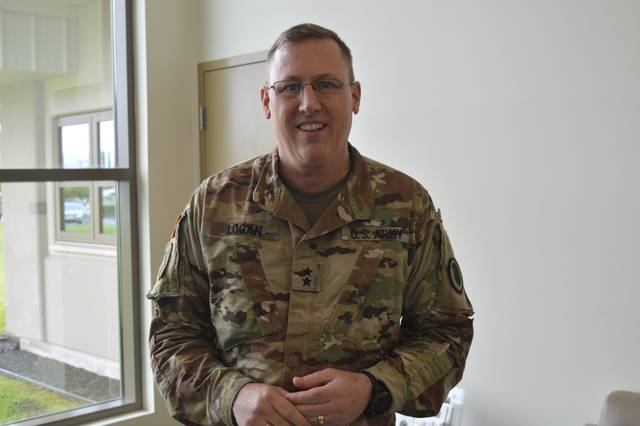HILO — During the Big Island’s state of emergency because of the Kilauea eruption, there are many whose plates are overflowing. Perhaps no one in Hawaii, however, has more responsibilities than Maj. Gen. Arthur J. “Joe” Logan.
The state’s adjutant general, who answers directly to Gov. David Ige, is in charge of the 5,500 soldiers and airmen of the Hawaii National Guard.
The men and women of the National Guard are still on Kauai because of the recent catastrophic floods, are supporting Joint Task Force 50 in response to the current lava crisis in Puna, and are deployed or preparing to deploy in support of operations in Iraq, Afghanistan, Kosovo, Japan and Korea.
Speaking to the Tribune-Herald Tuesday at Keaukaha Military Reservation in Hilo, Logan appealed to Big Islanders and residents statewide to prepare for another potential emergency situation, just around the corner: Hurricane season, which runs from June 1 to Nov. 30.
The Hawaii National Guard has experience dealing with dual disasters on the Big Island. The Guard responded to the June 27, 2014, lava flow that threatened Pahoa and Highway 130 for several months, and Tropical Storm Iselle, which devastated parts of Puna in August 2014.
Logan described the events of four years ago as “a good dry run” for the current situation.
“All of those were rehearsals for what we’re going through now,” Logan said. “We now understand a lot more about albizia trees and how … Tropical Storm Iselle devastated and basically cut off certain areas of Puna … with those albizia trees.”
Logan said emergency responders, including the National Guard, are prepared for hurricane season. He added that local residents, who understandably might be focused more on the current crisis, need to be proactive, as well.
“There’s a lot of things going on,” he said. “We’ve just got through flooding on the islands of Kauai and Oahu. Now we’re into a disaster with lava flow on the Big Island, but hurricane season is right around the corner. So I want everybody to be prepared. Don’t let all these other disasters that are ongoing be all you react to or be thinking about. We have to think about hurricane season coming around. We need you be prepared. We need you to, as much as you can afford, get two weeks worth of food, water and commodities. And don’t forget your pets, too, because your pets also need to be fed during a disaster period.”
Asked about the possible effects of a hurricane or tropical storm hitting the Big Island during the current lava crisis — which already is far more destructive than the slow-motion threat of the 2014 flow — Logan replied, “It would depend on where it came ashore.”
“I wouldn’t see a change in the response that we’re doing for the Puna area and the security mission that we need to do to support the county of Hawaii,” he said. “But we may have to bring more soldiers and airmen here to respond to the disaster. So it would be a separate disaster response, but we might put it under Joint Task Force 50, and they would run multiple operations.”
Logan emphasized that the current emergency and the potential for a tropical cyclone to hit the island in the next six months makes it imperative to respond with a sense of community.
“I want you to look out for your neighbors, know who your neighbors are,” he said. “Because first responders are not always police, fire and (emergency medical services). They are your neighbors. They’ll come to help you first during a disaster. So if you get to know your community … and then be prepared to help, yourself, within your community, I think that’s the best way to go, as far as resiliency, and how to recover and respond quicker to a disaster, if a tropical storm, hurricane or typhoon comes our way.”



